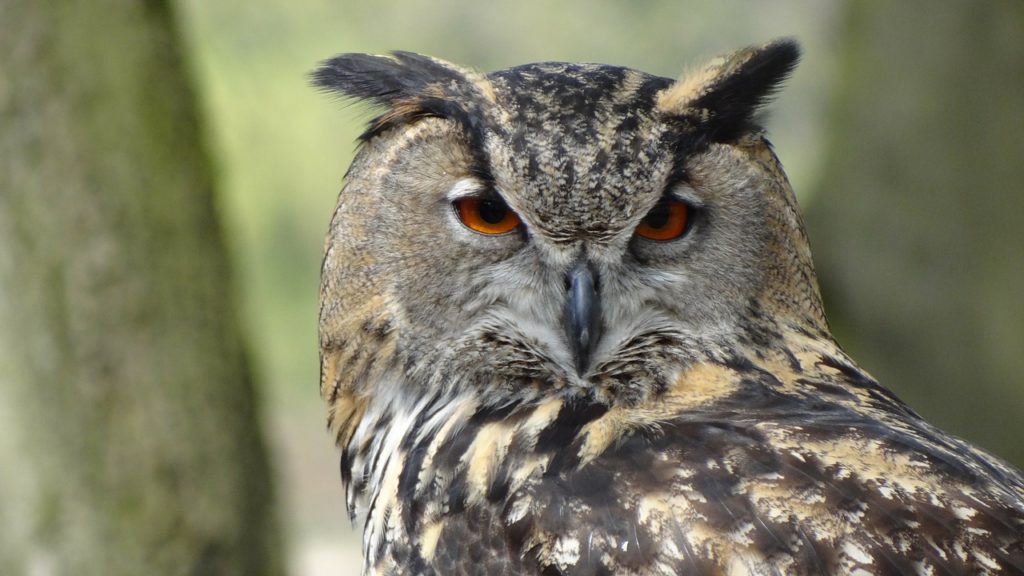 New York State is host to eight species of nesting owls, and most have found a home on Long Island. Our many preserves give bird watchers the best opportunity to see and hear these nocturnal hunters. As a bonus, winter time brings the migration of majestic snowy owls, a rare bird of the species that hunts by day. They will find their hunting grounds on the dunes of our beaches and marshes on the south shore.
New York State is host to eight species of nesting owls, and most have found a home on Long Island. Our many preserves give bird watchers the best opportunity to see and hear these nocturnal hunters. As a bonus, winter time brings the migration of majestic snowy owls, a rare bird of the species that hunts by day. They will find their hunting grounds on the dunes of our beaches and marshes on the south shore.
The haunting nocturnal calls of owls have entranced and intrigued humans for millenia. Aesop, in his fables, attributed wisdom to the birds, part of the anthropomorphizing of animals that our species is partial to. The attribute has stuck, and across disparate cultures and times, the owl has inspired awe and has been integrated into many mythologies.
By virtue of its geography, Long Island is home to an abundance and variety of birds, and owls can be counted among its avian census.
Owls are more often heard than seen, and their coloring and feather patterns help camouflage them as they roost among the foliage. Whether in a preserve, or park, or even in wooded suburban residential areas, these solitary raptors usually start their search for food (mainly small mammals) when the twilight begins.
Their hunting prowess starts with their eyes, forward facing and enabling binocular vision that puts their intended target in a three-dimensional field.
From their perches in trees or any high post with an unobstructed view of open ground, they will pinpoint their next meal with excellent night vision. Even if it cannot see the animal, the owl’s acute hearing—thought to be enhanced and amplified by their flat faces with slight curves and asymmetrical ears—can pinpoint animals under the cover of tall grasses or leaves and even snow. It is reported that owls can hear
the virtually silent footsteps of tiny mammals and even the heartbeat of a mouse at many yards.
Among their virtues are special feathers that enable the birds—some of whom, like the great horned owl, may have wingspans north of five feet—to fly silently and pounce upon skittish animals that would otherwise flee at any sound of danger.
Nature also gifted the bird with talons that exert as much as five times the pressure as a human hand grip. The talons, according to an online source, “have locking tendons that enable owls to grip their prey or hold on to branches without having to constantly contract muscles.”
Owls, like hawks and eagles (fellow members of the order strigiformes) swallow their kill whole (or in large portions) and produce pellets—portions of their prey that they cannot digest. Scientists study these to determine the birds’ feeding patterns and what kind of animal was eaten.
A good source of information for bird lovers in general is the South Shore Audubon Society, www.ssaudubon.org, or the Cornell Lab of Ornithology, www.birds.cornell.edu.

Owl Prowl for Adults
Owl lovers will get a chance to observe the birds at the annual adults-only Owl Prowl on Saturday, Oct. 29, from 6:30-8:30 p.m. at the Sands Point Preserve, 127 Middle Neck Rd., Sands Point.
According to a press release, this “is a wonderful opportunity to hear the Preserve’s wild owls calling in the woods. The program begins with an indoor presentation by biologist and Ranger Eric Powers. We’ll learn how to identify owls by sight and sound, and how to attract these beneficial birds to your own backyard. Then we’ll head out for a very quiet guided night walk in search of owls and other nighttime wildlife using a fun, safe, and easy method. Ranger Eric will teach you how to develop your own night vision—flashlights are not needed.”
Admission is $10 per car/members, $20 per car/non-members. Pay at the Gatehouse. Fee includes parking.
































